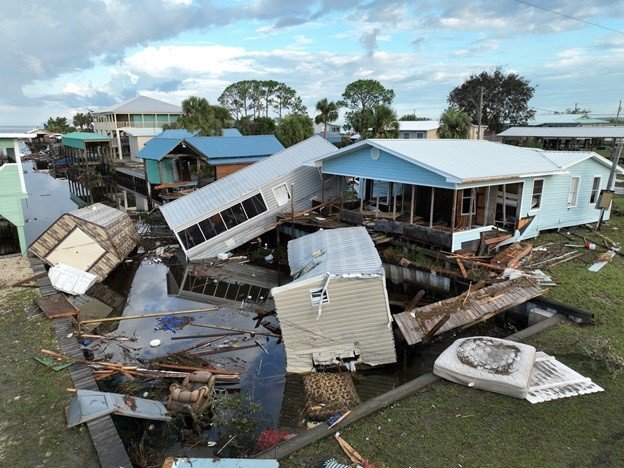Florida is conveniently one of the most storm-prone states in the US. This is down to several factors, including the following:
- Unique Topography – It has a flat topography for the most part. This offers very little leverage when faced with these harsh weather conditions
- Being Situated in a Coastline Area
- Susceptibility to Significant Rise in Water Levels
- Frequent Thunderstorms – Little wonder it is also nicknamed the country’s “lightning capital”
- Prolonged Hurricane Season
- Warm Climate
- Disadvantage in Trade Wind Direction
- Humidity Levels – Which can be sometimes extreme
The list goes on but only buttresses how much Florida is disadvantaged in this regard. By the way, this is not the only state that shares this fate, although some of the others may not have it as hard. For more information on this, you can visit: https://www.washingtonexaminer.com/.
As a result, residents of places like Florida had better brace up for the impact of bad storms. Read on as some proven tips for making one’s home in Florida bad storm-resistant will be shared here.
Effective Ways to Make Your Florida Home Storm-Resistant

You cannot stop the storm from coming. You also cannot reduce its intensity. However, you can ensure that your home is well protected even in the face of nature’s worst. This requires putting the right measures in place, including the following:
1. Take Care of Your Roof
The point could easily have started with the statement “reinforce your roof” which is every bit important. However, that would suggest that you have the right roof in the first place, which is not the case for everyone.
On this note, not every kind of roof will cut it in Florida and other states prone to bad storms. So, ensure that you invest in the right kind.
Metal roofs are very suitable. However, shingles are also an option, provided the kind purchased and used is impact-resistant.
Speaking of reinforcement, products like hurricane straps/clips should be strategically and generously used. This is so that your roof will withstand nature’s harsh force, especially when there are high winds.
Furthermore, regular inspection is a necessity. This is especially important when approaching those periods when Florida is most prone to these harsh weather conditions.
2. Use Impact-Resistant Doors & Windows

Some people go for regular doors and windows. For starters, they do not stand a chance against the intensity of Florida’s bad storms.
As a result, there would be a need for additional investment. This is by purchasing and using metal shutters which presents a long list of challenges including:
- Bad Aesthetic Impact
- Manual Effort
- Shutting Off Light & Visibility
- Noise
- Storage & Maintenance Troubles
- Operational Cost
Fortunately, impact-resistant doors and windows ensure that you do not have to deal with the odds brought about by the use of metal shutters. Furthermore, there are affordable premium hurricane windows and doors that can be purchased and professionally installed. Using such largely contributes to making your home bad storm-resistant.
3. Take Care of the Trees
Having trees around is good for health and environmental sustainability reasons. However, Florida is one place to be very cautious with them. This is because trees that are not properly pruned can cause serious havoc.
You should be more particular about trees that are close to your home. Ensure that there are no weak or dead parts that can give in to nature’s force and cause damage.
4. Ensure Outdoor Items Are Secured
Some home items are designed to be stationed outdoors. This can also be about space. By the way, patio furniture and grills fall perfectly into this category of items.
Such items should be properly secured outdoors if you would not be taking them indoors. Doing this ensures that they remain intact and serve their purpose for a very long time.
It is also about ensuring they do not become destructive. By the way, it is best if smaller items like gardening tools are stored indoors, especially during these periods.
Furthermore, outdoor structures like sheds, carports, and pergolas should be properly anchored. They can fly off due to high wind and cause damage due to their size and weight if this is not done.
5. Strategic Positioning of Electrical Systems
Electrical systems such as switches, HVAC systems, and outlets had better be elevated. Firstly, this ensures that they are not damaged if storms become serious to the point of flooding. Secondly, it is about protection from electrical hazards.
6. Use of Flood Barriers/Shields
Generally speaking, Florida is prone to bad storms as earlier established. However, some parts of the state are more susceptible than others.
For example, counties along the coastal areas such as Monroe, Miami-Dade, and Broward are prime examples of more susceptible parts of the state. The same goes for Tampa Bay and a couple of other parts.
To this end, people in more disadvantaged locations should invest in additional flood protection measures. Flood barriers/shields could come in very handy for people in such locations as they make entry points such as windows and doors less vulnerable to flooding.
7. Improve Drainage
Bad storms are not only about the harsh windy conditions. They are also a real test of a drainage system’s strength.
Bearing this in mind, invest in the improvement of your home’s drainage system. For example, your yard should be structured in such a way that water is directly away from your foundation.
Furthermore, adding a sump pump is a great idea as this takes water from the basement; which is a part of the home that can be very susceptible to flooding. Overall, the implementation of these two measures significantly protects your home, especially from flooding.
8. Foundation Enhancement
You can invest in foundation anchors as they help by further retrofitting your home’s structure. This helps your home stand a better chance when faced with the harshness of bad storms.
Conclusion

Florida and some other parts of the US are well known for how susceptible they are to bad storms. However, one can still live and thrive in this lovely part of the country, provided the right measures are taken for home protection. Eight (8) of these home protection measures have been shared here and should be taken seriously.











